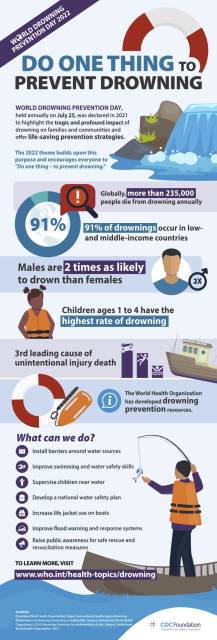You are here
World Drowning Prevention Day 2022: Do One Thing to Prevent Drowning
Drowning claims the lives of 236,000 people each year, making drowning the third-leading cause of unintentional injury and death . Over 90 percent of drowning deaths occur in low- and middle-income countries, and though most drownings are preventable, a lack of focused resources to address this issue has perpetuated its devastating impact in communities globally.
In 2021, the World Health Organization declared July 25 each year as World Drowning Prevention Day, to highlight the tragic and profound impact of drowning on families and communities and offer life-saving prevention strategies. This year, the WHO calls upon individuals, organizations, and governments to “Do One Thing” to promote drowning prevention. In honor of that theme, the CDC Foundation is recognizing World Drowning Prevention Day by sharing our collaborative work with Bloomberg Philanthropies, CDC, and in-country partners through the Understanding and Preventing Drowning in sub-Saharan Africa, which is establishing major milestones in global drowning prevention research in Uganda and Ghana.
Evidence-based prevention strategies like installing barriers around water sources, teaching water safety skills and implementing boating regulations have proven effective at preventing drowning. Before we can design, implement and monitor such strategies, it is crucial to understand the burden and circumstances surrounding drowning at a country level. However, with limited drowning data available in low- and middle-income countries, our understanding of contextual factors and impact of drowning is incomplete or misleading.
In 2018, the CDC Foundation and the U.S. Centers for Disease Control and Prevention (CDC) partnered with Makerere University School of Public Health researchers to identify fatal and non-fatal drowning cases in Uganda. Researchers collected administrative data from police offices, fire departments and mortuaries and conducted interviews with survivors, witnesses and family members for drowning cases that occurred between January 2016 and June 2018. This study found that in 12 of the 14 study districts, the drowning death rate was higher than the WHO African regional rate of 8.0 per 100,000 individuals.
Since 2020, the CDC Foundation and CDC have partnered with Kwame Nkrumah University of Science and Technology to understand the burden and circumstances of drowning in Ghana. The study aims to: (1) establish the availability of drowning data, (2) describe the burden of drowning including estimating a nationally representative drowning rate, the first in sub-Saharan Africa, and (3) describe the circumstances of drowning in Ghana. These data will help identify key risk factors of drowning–such as the ages and sexes of victims, whether the incident was flood related and if there was a rescue attempt made by authorities or witnesses–to inform appropriate prevention and intervention strategies. Data collection for the study, which also examines the activity at time of drowning, life jacket use, swimming skills and boating-related information, will continue through December 2022.
Drowning is a preventable tragedy that requires more global attention. By bolstering data availability and establishing contextual understandings we can prevent thousands of lives lost to drowning each year. To learn more about current global efforts to prevent drowning, visit the WHO’s World Drowning Prevention Day 2022 website. The CDC Foundation encourages you to take part in this year’s World Drowning Prevention Day and identify the one thing you can do to help prevent drowning around the world.

